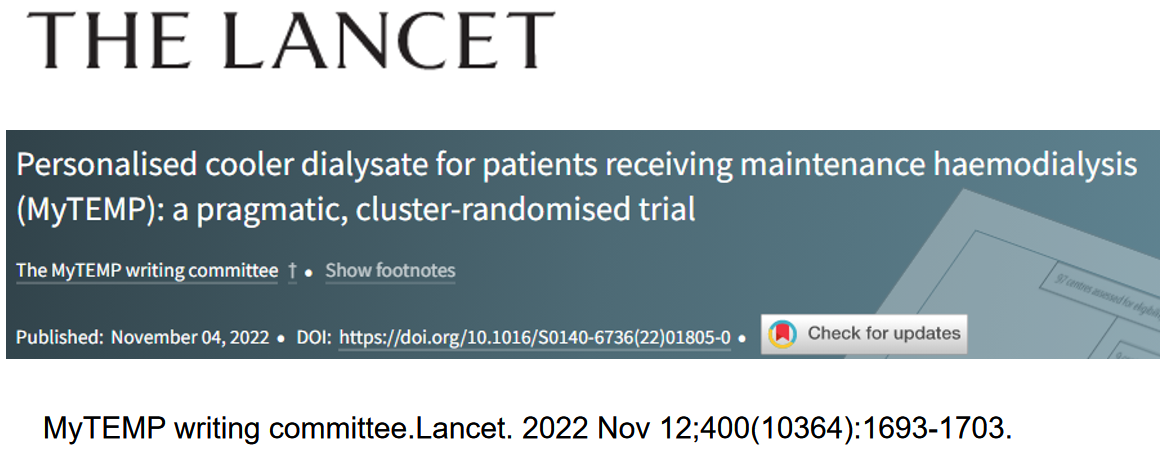2022-11-21


血液透析中心通常使用标准透析液温度(如36·5°C)为所有患者提供维持式血液透析。许多中心现在使用较冷的透析液(如36·0°C或更低),以获得潜在的心血管益处。我们的目的是评估作为中心范围政策实施的个性化低温透析,与标准温度透析相比,是否降低了心血管相关死亡或住院的风险。
在此期间,试验中心为15 413例患者提供了门诊维持性血液透析(约430万次血液透析治疗)。在较冷透析液组和标准温度组中,平均透析液温度分别为35.8℃和36.4℃。较低温透析液组8,000例患者中的1,711例(21.4%)发生了主要结局,而标准体温组7,413例患者中的1,658例(22.4%)发生了主要结局(校正后的风险比1.00,96% CI 0.89 ~ 1.11;p = 0·93)。在较冷透析液组和标准温度组中,透析中收缩压的平均降幅分别为26.6 mmhg和27.1 mmhg(平均差- 0.5 mmhg, 99% CI - 1.4 ~ 0.4;p = 0·14)
与标准温度透析相比,在中心范围内提供个性化较冷的透析液并没有显著降低主要心血管事件的风险。本研究对低温透析液的日益流行提出了质疑,在一些患者人群中低温透析液的风险和好处应在未来的试验中澄清。
Abstract
Background: Haemodialysis centres have conventionally provided maintenance haemodialysis using a standard dialysate temperature (eg, 36·5°C) for all patients. Many centres now use cooler dialysate (eg, 36·0°C or lower) for potential cardiovascular benefits. We aimed to assess whether personalised cooler dialysate, implemented as centre-wide policy, reduced the risk of cardiovascular-related death or hospital admission compared with standard temperature dialysate.
Methods: MyTEMP was a pragmatic, two-arm, parallel-group, registry-based, open-label, cluster-randomised, superiority trial done at haemodialysis centres in Ontario, Canada. Eligible centres provided maintenance haemodialysis to at least 15 patients a week, and the medical director of each centre had to confirm that their centre would deliver the assigned intervention. Using covariate-constrained randomisation, we allocated 84 centres (1:1) to use either personalised cooler dialysate (nurses set the dialysate temperature 0·5-0·9°C below each patient's measured pre-dialysis body temperature, with a lowest recommended dialysate temperature of 35·5°C), or standard temperature dialysate (36·5°C for all patients and treatments). Patients and health-care providers were not masked to the group assignment; however, the primary outcome was recorded in provincial databases by medical coders who were unaware of the trial or the centres' group assignment. The primary composite outcome was cardiovascular-related death or hospital admission with myocardial infarction, ischaemic stroke, or congestive heart failure during the 4-year trial period. Analysis was by intention to treat. The study is registered at ClinicalTrials.gov, NCT02628366.
Findings: We assessed all of Ontario's 97 centres for inclusion into the study. Nine centres had less than 15 patients and one director requested that four of their seven centres not participate. 84 centres were recruited and on Feb 1, 2017, these centres were randomly assigned to administer personalised cooler dialysate (42 centres) or standard temperature dialysate (42 centres). The intervention period was from April 3, 2017, to March 31, 2021, and during this time the trial centres provided outpatient maintenance haemodialysis to 15 413 patients (about 4·3 million haemodialysis treatments). The mean dialysate temperature was 35·8°C in the cooler dialysate group and 36·4°C in the standard temperature group. The primary outcome occurred in 1711 (21·4%) of 8000 patients in the cooler dialysate group versus 1658 (22·4%) of 7413 patients in the standard temperature group (adjusted hazard ratio 1·00, 96% CI 0·89 to 1·11; p=0·93). The mean drop in intradialytic systolic blood pressure was 26·6 mm Hg in the cooler dialysate group and 27·1 mm Hg in the standard temperature group (mean difference -0·5 mm Hg, 99% CI -1·4 to 0·4; p=0·14).
Interpretation: Centre-wide delivery of personalised cooler dialysate did not significantly reduce the risk of major cardiovascular events compared with standard temperature dialysate. The rising popularity of cooler dialysate is called into question by this study, and the risks and benefits of cooler dialysate in some patient populations should be clarified in future trials.
Funding: Canadian Institutes of Health Research, Heart and Stroke Foundation of Canada, Ontario Renal Network, Ontario Strategy for Patient-Oriented Research Support Unit, Dialysis Clinic, Inc., ICES (formerly known as the Institute for Clinical Evaluative Sciences), Lawson Health Research Institute, and Western University.
文章连接:
www.thelancet.com/journals/lancet/article/PIIS0140-6736(22)01805-0/fulltext
百度浏览 来源 : 医微客
版权声明:本网站所有注明来源“医微客”的文字、图片和音视频资料,版权均属于医微客所有,非经授权,任何媒体、网站或个人不得转载,授权转载时须注明来源:”医微客”。本网所有转载文章系出于传递更多信息之目的,且明确注明来源和作者,转载仅作观点分享,版权归原作者所有。不希望被转载的媒体或个人可与我们联系,我们将立即进行删除处理。 本站拥有对此声明的最终解释权。




发表评论
注册或登后即可发表评论
登录注册
全部评论(0)